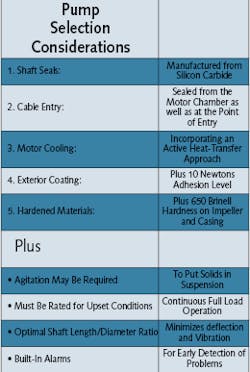Pumping FGD Sludge (and Other Difficult) Slurries, Economically - Pump Selection Considerations
Flue gas desulfurization (FGD) is a process by which the exhaust gas at fossil-fired power plants is rendered safe for discharge to the atmosphere. FGD slurries are relatively abrasive, corrosive, and dense. To pump aggressive slurries reliably, a pump has to be specifically engineered for smooth, cool operation. It must be manufactured in materials suited for the particular slurry, assembled precisely and properly coated.
Achieving Optimum Value
To avoid unplanned downtime, weak points need to be understood and addressed. Areas to be considered with aggressive slurries include shaft sealing, cable entry and cooling.
By the Numbers
No. 1, silicon carbide mechanical seal faces are required. Tests show silicon carbide shaft seals are 15-20 times more durable than ceramic carbon and 2.5-3 times more durable than tungsten carbide. Seal faces must be flat - (a relative term, but the flatter the better) - to exclude fine particles; and the springs providing tension to close these faces should be isolated from the slurry.
No. 2, the cable entry should be sealed from the motor chamber so integrity of the motor is maintained in event of moisture intrusion from the top and a positive strain relief mechanism should be provided. Individual conductors stripped down to bare wire, passing through an epoxy barrier, precludes moisture from a damaged cable entering the stator cavity. Further protection is provided by an isolated terminal board, O-ring sealed. This board can be built to facilitate field voltage changes as well.
No. 3, generally, heat can be dissipated through the motor housing to the pumped medium. A means to continuously dissipate motor heat through a heat exchanger should be incorporated − even when gypsum or other material may cause an insulating build-up of material. The cooling method should be rated for 24/7 operation, under full load.
Positive internal cooling methods permit pumping to a lower level in the sump, which increases sump capacity; this can translate into hundreds of gallons of sump capacity.
No. 4, protective coatings require high adhesion characteristics because of hydraulic forces inside the sump. Low adhesion coatings can fail prematurely. (Adhesion is measured in Newtons per-square-millimeter (N/mm2).) For example, a standard industrial paint coating has an adhesion level of about 4 N/mm2, while a two-component coating with a high percentage of solids has an adhesion level of approximately 7 N/mm2. Today, there are liquid ceramic coatings that provide an adhesion level of 15 N/mm2. The elastomer component resists corrosion and impregnated ceramic resists abrasion.
No. 5, hardened high-chrome material (to 650 plus BHN; Rockwell “C” scale of 63) should be supplied when abrasion is the main issue. In cases where corrosion is more of a concern, then Duplex Stainless Steels such as CD4MCU should be utilized.
Other Considerations
Solids may settle when the pumps aren’t running; agitation may be required. A pump with a built-in (or add-on) mixer head can help close to the pump. For the larger area, external agitators or separate submersible mixers may be required to put solids into suspension prior to having the pumps cycle on.
Upset conditions may require that the pumps run continuously under full load and the pump should be rated for such conditions even though normal operation is intermittent.
Over time, parts wear out and the rotating element will no longer be in near-perfect balance. The shaft and bearing assembly must minimize deflection and vibration in the worn condition, to prolong bearing and mechanical seal life. The shorter the distance from the bearing to the impeller centerline, the better. Look for an optimal L/D (length/diameter) ratio.
A submersible pump for aggressive duty will have built-in protective alarms.
A moisture sensing probe can detect water intrusion in the mechanical seal chamber before there is any damage to the stator. Thermistors in the windings can protect the motor from being overloaded. The control system logic should merely report certain indications. Under more severe conditions pumps should be taken off-line. Critical sumps should have spare units on site, installed when space allows.
About the Author: Jed Pratt is vice president of sales, industrial markets, for Wilo EMU USA LLC, of Thomasville, GA. He has many years of in-depth experience in the application of industrial pumps and mixing systems. Contact: [email protected] or www.wilo-emu-usa.com

